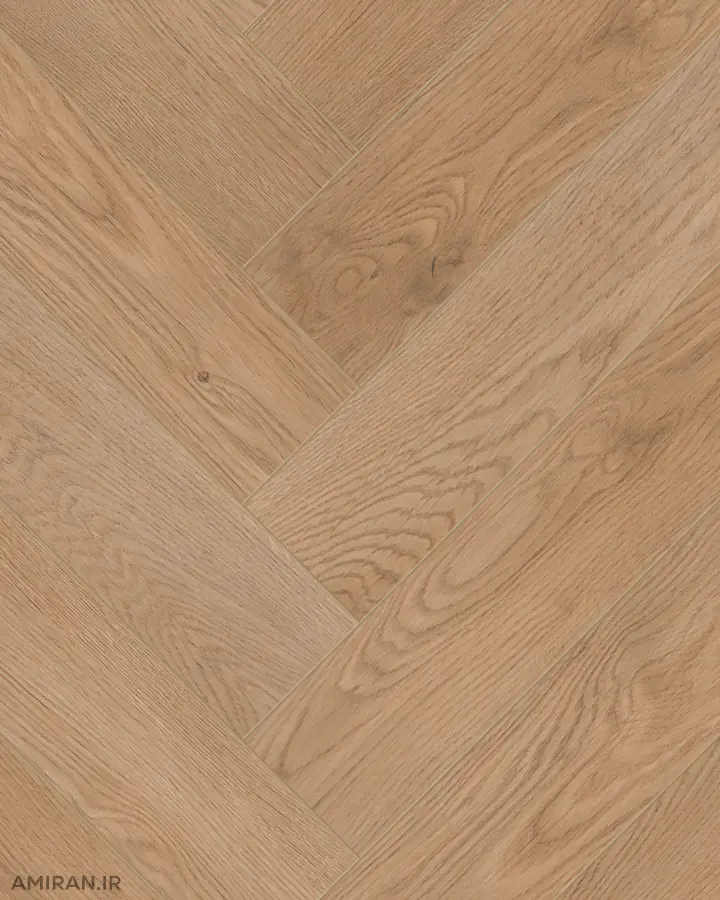Engineered laminate flooring, a modern and popular choice for flooring, combines the elegance of wood with advanced technology to create a durable, beautiful, and practical product. This type of flooring serves as an ideal alternative to traditional solid wood flooring and standard laminate, offering numerous advantages.
Structure of Engineered Laminate Flooring
Unlike solid wood flooring made from a single piece of wood, engineered laminate flooring consists of several layers:
- Wear Layer: This thin layer of real wood provides the flooring with its beauty and warmth. The thickness of this layer varies in different types of engineered laminate flooring and can range from 0.6 to 6 millimeters.
- Core Layer: Made of High-Density Fiberboard (HDF) or Medium-Density Fiberboard (MDF), this layer provides strength and stability to the flooring. It also prevents the flooring from warping or bending due to changes in temperature and humidity.
- Backing Layer: Made of plastic or foam, this layer acts as a sound and heat insulator. It also increases the flooring's flexibility and makes it easier to install.
Advantages of Engineered Laminate Flooring
- Long Lifespan: Engineered laminate flooring is resistant to wear, impact, and scratches, making it durable for many years.
- Easy Installation: Engineered laminate flooring is installed using a click-and-lock system, eliminating the need for glue or nails. This makes installation quick and easy, and allows for easy replacement or relocation.
- Beauty and Variety: Engineered laminate flooring is available in a wide range of natural wood designs and colors, adding warmth and character to any space.
- Durability and Strength: This type of flooring is resistant to wear, impact, and scratches, making it suitable for high-traffic areas such as living rooms, bedrooms, and hallways.
- Moisture Resistance: Engineered laminate flooring is somewhat resistant to moisture and can be used in areas like kitchens and bathrooms. However, it is not suitable for extremely wet areas like showers.
- Affordability: Compared to traditional solid wood flooring, engineered laminate flooring is more affordable.
Applications of Engineered Laminate Flooring
Engineered laminate flooring can be used in various areas of a home.
- Residential: Suitable for all areas of the home, including living rooms, bedrooms, hallways, kitchens, and even bathrooms (except for showers).
- Commercial: Due to its durability and aesthetics, it is also an excellent choice for offices and commercial spaces.
- Public Spaces: Engineered laminate flooring can be used in public areas such as hotels, restaurants, and libraries. It can withstand high foot traffic and adds elegance to the space.
Choosing the Right Color for Different Spaces
Choosing the right color for engineered laminate flooring can significantly impact the feel and look of a space.
- Living Room: Light colors like white, cream, and beige can make the space appear larger and brighter. Warm colors like light brown, honey, and oak can create a cozy and inviting atmosphere. Neutral colors like gray and taupe can complement any decor style.
- Bedroom: Light colors can create a calming and relaxing atmosphere. Warm colors can add warmth and coziness. Neutral colors can provide a versatile backdrop.
- Bathroom: Light colors can make the space feel larger and brighter. Neutral colors like gray and taupe can create a modern and stylish look. Blue can add a refreshing and calming feel.
Note: When choosing engineered laminate flooring, consider the thickness of the wear layer, the type of core layer, and the product warranty. For professional installation, consult with flooring experts. When selecting a color, consider the room's lighting and existing decor.
Conclusion: Engineered laminate flooring offers the perfect combination of beauty and durability. With its numerous advantages, it has become a popular choice for homeowners and businesses alike. By carefully considering the factors mentioned above, you can choose the perfect engineered laminate flooring for your space.












